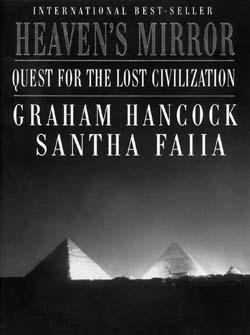
Heaven's Mirror: Quest for the Lost Civilization
by Graham Hancock, photographs by Santha Faiia, Three Rivers Press (Random House), 1998; ISBN 0-609-8477-4, 352 pages, paper, $25.00.Stairways to the Stars -- Skywatching in Three Great Ancient Cultures
by Anthony Aveni, John Wiley & Sons, 1997; ISBN 0-471-3297-2, 230 pages, paper, $15.95.Several books which appeared in the late years of the twentieth century suggest that we had better discard the idea that we have a relatively complete understanding of human history, or that we have created the very first highly technological civilization our planet has known. Civilizations in the remote past have left behind ample testimony to their remarkable achievements in architecture, engineering, astronomy, and other fields. New finds, and the reinterpretation of existing evidence, are resulting in fresh assessments of ancient peoples and their cultures. (Cf. "Humanity's `Lost Civilization,' " Sunrise, April/May 1997.)
Graham Hancock, author of Fingerprints of the Gods, has written an important new book, Heaven's Mirror: Quest for the Lost Civilization. Its main thesis is that evidence exists that anciently there was one civilization spanning many countries that left behind traces of its vast achievements, this testimony being transmitted through millennia of time. Cooperating with Hancock is his wife, Santha Faiia, whose photographs in this book are breathtaking and make visible before our eyes the statements in the text. I can only liken their impact to the illustrations in the rare Napoleon Volumes produced by the French archaeologists and artists invited by Napoleon to accompany his occupying forces to Egypt in the late 1790s. Certainly this latest volume by Graham Hancock is a "must see."
The importance of this work lies in the author's discovery of the unifying thread that binds together the insights from previous cultures from east to west, north to south, which are expressed in the oldest remains of temples and other structures. We find them in pre-Dynastic Egypt at the city of Anu or On, called Heliopolis by the later Greeks, as well as at the city of Khemenu, dedicated to Tehuti, Djehuti, or Thoth, whom later Greeks called Hermes Trismegistus. Both were linked to the Shemsu Hor, Friends, Followers, or Sons of Horus, a mysterious brotherhood of teachers said to have founded Heliopolis. The same insights appear in cultures of Mesopotamia, whose main tangible testimonies are the ziggurats of Assyria/Babylonia; in Cambodia at Angkor Wat; on the Pacific Islands; and across the seas in Central and South America. In each case, a similar cosmological system "is associated with a school of sacred geometry and architecture and a cult of celestial imitation that finds mysterious virtue in making `copies' on the ground -- models, symbolic schemes -- of certain constellations in the sky" (p. 259). Evaluating these ancient monuments, and the myths and scriptures connected with them, the author concludes that they "are all parts of the vast apparatus of an archaic spiritual system aimed at enabling those who had proved their worth to initiate themselves into the mystery of eternal life" (p. 319).
The astronomical alignments of several major structures have led Hancock and others to believe that this cosmological system relates to the sky of the spring equinox in 10,500 BC. This date marks the midpoint of the precessional cycle of 25,920 years, when the key constellations of Draco and Orion, on the north-south meridian, reached respectively their maximum and minimum altitude or culmination. Today this cycle has almost reached the opposite midpoint, marking the beginning of another period of some 12,500 years, an astronomical configuration that Hancock interprets "as a sign that some great change is imminent" for the earth and humanity (p. 198).
Also worthy of serious attention is Stairways to the Stars -- Skywatching in Three Great Ancient Cultures by Anthony Aveni, Professor of Astronomy and Anthropology at Colgate University, who is a pioneer of archaeoastronomy. Here he examines Stonehenge, giving evidence for its being an ancient observatory, calendar, temple, and meeting place. Turning to the Americas, he explores the Maya ruins at Chichen Itza in light of the Mayan Code and indigenous mathematics. One conclusion he draws is that the planet Venus influenced all aspects of Maya society. Moving south, he shows the ancient Inca capital in the Cuzco valley to be a vast observatory. The diagrams and photographs in this volume are valuable additions to the knowledge that the text conveys.
(From Sunrise magazine, October/November 2000; copyright © 2000 Theosophical University Press)
The Greeks did not abstract away the outside world to prefer the claims of the world within; neither did they deny the spirit in favor of its incarnation. To them the frame and the picture fitted; the things that are seen and the things that are not seen harmonized.
For a hundred years Athens was a city where the great spiritual forces that war in men's minds flowed along together in peace; law and freedom, truth and religion, beauty and goodness, the objective and the subjective -- there was a truce to their eternal warfare, and the result was the balance and clarity, the harmony and completeness, the word Greek has come to stand for. They saw both sides of the paradox of truth, giving predominance to neither, and in all Greek art there is an absence of struggle, a reconciling power, something of calm and serenity, the world has yet to see again. -- Edith Hamilton, The Greek Way